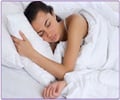
"We found it shocking that light exposure as brief as a few milliseconds could engender changes in alertness and brain wave activity," said principal investigator Jamie M. Zeitzer, PhD, assistant professor in the department of psychiatry and behavioral sciences at Stanford University in Palo Alto, Calif. "These results change the manner in which we think about the brain's capacity to respond to light."
The randomized crossover study involved seven people who were tested two times, with the sessions separated by more than two weeks. In each testing condition they were wakened two hours after their typical bedtime for stimulus administration. Once they were exposed to an hour of darkness, and once they were exposed to a total of 120 milliseconds of bright light pulses during an hour of darkness. Vigilance was measured immediately before and at the end of the 60-minute stimulus.
According to the American Academy of Sleep Medicine, the solar light-dark cycle is the primary environmental time cue for synchronizing the circadian system to the 24-hour day. Artificial light absorbed by visual photoreceptors also can affect circadian timing by triggering the suppression of melatonin, a hormone that acts as a "darkness signal."
AASM practice parameters indicate that timed light exposure in the work environment can decrease sleepiness and improve alertness during night shift work. However, bright light therapy typically involves exposure to up to 10,000 lux of light for scheduled periods of 20 minutes or more.
Advertisement









